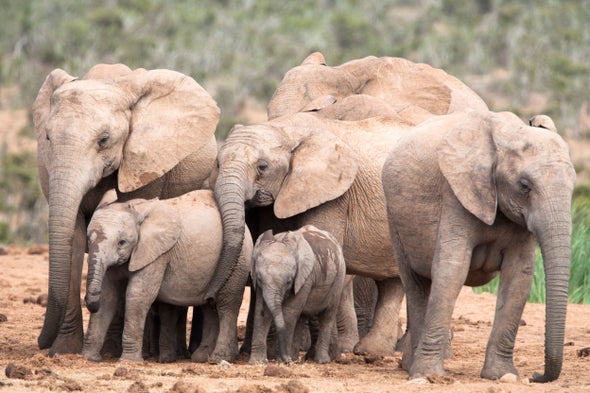Running wolves, flying bats and swimming dolphins seem to have few similarities. But these widely disparate animals are among at least 240 mammalian species—including humans—that share a full 10 percent of their genome. This discovery includes more than 400,000 never-before-identified stretches of DNA that likely control the way that genes—the segments of genetic material that code for proteins—actually function. The newly analyzed regions were highlighted in papers published today in Science detailing the first effort to directly compare 240 mammalian genome sequences. The new database, from a collaboration called Zoonomia, also identified parts of the DNA code that give some mammals extraordinary abilities such as hibernation or the ability to smell scents miles away.
Until now, most studies that looked at mammalian genomes used the human genome as a reference to figure out how an animal species’ genome fits together and how it evolved. But this measuring stick is only useful if sequences of human DNA are similar to an animal’s. In animals that have specific nonhuman adaptations or traits, such as hibernation, genetic similarities to people may not exist.
To get around this problem, dozens of researchers at the Zoonomia project, led by genomicists Elinor Karlsson of the Broad Institute of the Massachusetts Institute of Technology and Harvard University and Kerstin Lindblad-Toh of Uppsala University in Sweden, collected the genome sequences of 240 mammalian species, including humans and two breeds of domestic dogs. They and their collaborators ran these through an algorithm that compared all the genomes to one another.
Aligning the genomes in this way allowed the researchers to spot similarities and differences between species, even if those species are only distantly related. Some bat species, for instance, hibernate like bears, while other closely related bat species do not. The genome alignment revealed DNA regions that are shared only among bears, hibernating bats and still other hibernators. These regions included genes involved in temperature regulation, metabolism and repairing damaged neurons.
The researchers also found similarities among animal species that have a strong sense of smell. Rodents, they found, tend to have the most genes for olfactory receptor proteins that pick up scents. But even the best-sniffing rodent, the Central American agouti, had fewer olfactory genes than three other species. The African savanna elephant, with 4,199 genes devoted to smell, has the most of any animal. The researchers also found that animals that live alone tend to have more olfactory genes than those that live in groups. This may be because solo animals need better abilities to sense predators and prey because they cannot depend on a network of companions for warnings.
Having 240 genomes to compare allowed the researchers to see where regions of the DNA code were identical across mammalian species. These conserved regions are likely very important to mammalian survival because mammals kept them around throughout their evolution.
Some previous estimates had suggested as little as 3 percent of the human genome was similar to that of all other mammals. But when the Zoonomia team searched for similarities, it found that 10.7 percent of the human genome appeared similar to our mammalian compatriots. And remarkably, only 20 percent of these conserved regions were in parts of genes that code for proteins. The majority of conserved areas were in other areas of the chromosome that could affect how different genes are turned off or on or how active they become. These so-called regulatory elements can affect gene expression in a number of ways: they can bend a DNA strand to help cellular machinery bind to a gene and ultimately create more of a protein, for instance.
The researchers found 423,586 potential regulatory elements, which they call unannotated intergenic constrained regions (UNICORNs). Many of these are located close to genes that affect the way animals interact with their environment, such as skin development, as well as the ability to adapt to change. Lindblad-Toh says that UNICORNs almost certainly affect gene regulation in ways that are not yet understood.
These UNICORNs have never been identified before, even by large scientific collaborations that have looked at hundreds of thousands of human genomes in great depth. “We didn’t need perfection; we just needed a large number of species to compare to each other,” Karlsson says.
David Kingsley, a developmental biologist at Stanford University, who was not involved with the research, says that aligning genomes can reveal far more about a species’ genetics and biology than studying each species individually—at least as a first step. “It’s taking advantage of all these experiments of nature, which are way more extensive than the experiments that have been done” by humans, he says. He hopes that biologists will use this information to dig even further into the regulatory DNA that is important in defining species’ behavior and adaptations.
The challenge now, Karlsson says, is to better understand the physiology and behavior of animal species to better identify their genetic similarities. “Someone has to study 240 species to find out if they hibernate and how big their brains are,” she says. She and Lindblad-Toh plan to add more primate genomes to the database, which will allow them to better determine how humans evolved. But the most important findings, they say, will come once other researchers start to study the genetics of their favorite species. Because most mammals’ genomes have not been fully sequenced—particularly the parts that are not inside genes—the Zoonomia database can fill in many of the gaps and allow scientists to ask new questions.
“It’s a really amazing resource they’ve created,” says Nathan Clark, an evolutionary genomicist at the University of Utah, who was not involved with the research. He says the database will be useful to groups such as his that are either interested in a specific species or in traits such as a long life span, incredible vision and the ability to live at high altitudes. “This is only the beginning,” Clark says.

